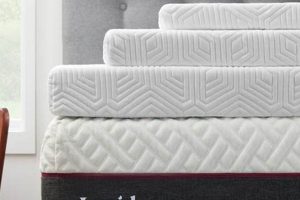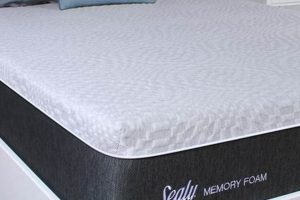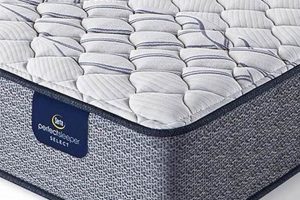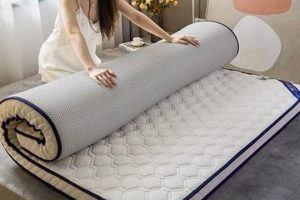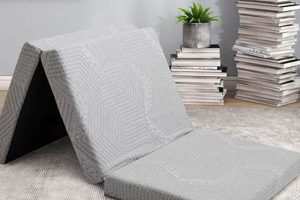Discomfort experienced in the back region, potentially ranging from mild soreness to debilitating pain, can sometimes be attributed to the characteristics of the sleep surface. Individuals may find that the material composition and design of their mattress contribute to, or exacerbate, existing spinal issues. For instance, a sleeping surface that does not adequately support the natural curvature of the spine may lead to muscle strain and subsequent pain.
The quality of sleep, spinal alignment, and overall musculoskeletal health are closely intertwined. Historically, mattress construction focused primarily on cost-effectiveness and durability. Contemporary designs increasingly prioritize ergonomic support and pressure relief. Mattresses are now engineered with varying degrees of firmness and material density, aiming to accommodate diverse body types and sleep preferences, ultimately promoting a healthier sleep posture.
Therefore, understanding the relationship between mattress characteristics and back discomfort is crucial. The following sections will delve into specific factors that contribute to spinal strain during sleep, explore different mattress types and their potential effects, and provide guidance on selecting a sleep surface that promotes optimal spinal health and minimizes the potential for sleep-related back discomfort.
Addressing Mattress-Related Back Discomfort
The following recommendations address factors that can contribute to, or alleviate, back discomfort potentially stemming from mattress characteristics. Implementation of these strategies may assist in achieving more restful sleep and improved spinal health.
Tip 1: Evaluate Mattress Firmness. A mattress should provide adequate support to maintain natural spinal alignment. A surface that is too soft may allow excessive sinking, while one that is too firm may create pressure points. Consider a medium-firm option as a starting point, adjusting based on individual preference and body type.
Tip 2: Assess Sleeping Position. Different sleeping positions place varying degrees of stress on the spine. Side sleepers may benefit from a mattress that contours to the body, while back sleepers often require more uniform support. Experiment with different positions to identify what minimizes discomfort.
Tip 3: Examine Mattress Material. The material composition of a mattress significantly impacts its support and pressure relief characteristics. Consider materials designed to distribute weight evenly and minimize pressure points, such as those found in modern hybrid mattress constructions.
Tip 4: Consider Mattress Age. Over time, mattresses lose their supportive qualities, potentially contributing to back discomfort. A mattress beyond its recommended lifespan may require replacement. Refer to the manufacturer’s guidelines regarding expected lifespan.
Tip 5: Optimize Sleep Environment. Factors such as pillow height, room temperature, and ambient noise can influence sleep quality. Ensure a comfortable and supportive sleep environment to promote relaxation and reduce muscle tension.
Tip 6: Consult a Professional. If back discomfort persists despite adjustments to the mattress and sleep environment, seek advice from a qualified medical professional. A healthcare provider can assess underlying medical conditions and recommend appropriate treatment strategies.
These recommendations aim to improve sleep quality and reduce mattress-related back discomfort. Careful consideration of mattress characteristics, sleeping position, and environmental factors is essential for promoting optimal spinal health.
The subsequent section will explore various treatment and preventative strategies for sleep-related back pain, including physical therapy and lifestyle modifications.
1. Firmness Level
The firmness level of a memory foam mattress is a primary determinant of its effect on back discomfort. A mattress’s firmness, or lack thereof, directly affects spinal alignment, which is a critical factor in the development or exacerbation of back ache. A memory foam mattress that is too soft may allow the sleeper’s hips to sink excessively, causing the spine to curve unnaturally. This misalignment can strain the muscles and ligaments in the back, leading to discomfort. Conversely, a memory foam mattress that is too firm may not conform adequately to the body’s contours, resulting in pressure points, particularly in the shoulders and hips. These pressure points can also trigger or intensify back ache.
The ideal firmness level for a memory foam mattress is highly individual and depends on factors such as sleeping position, body weight, and pre-existing medical conditions. For example, side sleepers generally benefit from a slightly softer mattress that allows their shoulders and hips to sink in slightly, maintaining spinal alignment. Back sleepers often require a firmer surface to prevent excessive sinking of the hips. Individuals with higher body weights typically need a firmer mattress to provide adequate support. Ignoring these individual needs can negate the potential benefits of memory foam, leading to, or exacerbating, back discomfort.
In summary, the connection between firmness level and back ache is significant. A properly chosen firmness level promotes spinal alignment and reduces pressure points, contributing to pain alleviation. Incorrect firmness can lead to spinal misalignment, increasing pressure points, and ultimately, leading to pain. Therefore, a judicious selection of a memory foam mattress with appropriate firmness is paramount in mitigating or preventing mattress-related back pain. Ignoring this can negate any benefit memory foam would otherwise provide.
2. Spinal Alignment
The role of spinal alignment is paramount in understanding the connection between a memory foam mattress and back discomfort. Proper alignment ensures that the spine maintains its natural curvature during sleep, minimizing stress on the muscles, ligaments, and intervertebral discs. A memory foam mattress that fails to support this natural alignment can contribute directly to back ache. The spine is comprised of vertebrae and intervening cartilage, each contributing flexibility and support. When the spine is misaligned, the pressure is unevenly distributed across the vertebrae, and the supporting muscles must work harder to stabilize the body. This strain leads to muscle fatigue and pain.
For example, consider a memory foam mattress that is excessively soft. In this scenario, the midsection of the body may sink too deeply into the mattress, causing the spine to curve into a U-shape. This curvature stretches the ligaments along the back of the spine and compresses the discs in the lower back. Over time, this can lead to chronic pain and, in severe cases, disc degeneration. Conversely, a mattress that offers insufficient give may force the spi
ne into a rigid, unnatural posture, leading to pain due to lack of proper support. Understanding this relationship is crucial because it allows individuals to make informed choices about their sleep surface. A mattress designed to maintain spinal alignment can alleviate existing back discomfort and prevent the development of future problems.
In conclusion, spinal alignment is a critical component in mitigating or preventing mattress-related back ache. Memory foam mattresses must provide adequate support and contouring to maintain the spine’s natural curvature, thereby minimizing stress and strain. Recognizing the vital role of spinal alignment empowers individuals to select appropriate mattresses, potentially improving sleep quality and promoting overall spinal health. Prioritizing spinal alignment in mattress selection represents a proactive step in safeguarding against sleep-related back pain.
3. Pressure Points
Pressure points, areas of concentrated force between the body and the mattress, are a significant contributing factor to back discomfort experienced with memory foam mattresses. When a mattress fails to distribute weight evenly, certain areas, such as the hips, shoulders, and back, bear a disproportionate amount of pressure. This localized pressure restricts blood flow, irritates nerves, and causes muscle tension, ultimately leading to ache. A typical scenario involves a side sleeper on a mattress that is too firm. The shoulder and hip, being the widest points of the body, create high-pressure zones against the unyielding surface. This sustained pressure can lead to significant discomfort and disrupted sleep. Reducing these pressure points, therefore, is a primary goal in minimizing mattress-related back discomfort.
Memory foam mattresses, while often touted for their pressure-relieving properties, can paradoxically contribute to pressure point formation if not properly matched to the individual’s needs. A mattress that is too soft may allow excessive sinking, leading to pressure points around the lower back as the body struggles to maintain spinal alignment. A mattress that is too firm, conversely, may not conform adequately to the body’s contours, creating pressure points at the hips and shoulders. The effectiveness of a memory foam mattress in alleviating pressure points depends on factors such as foam density, thickness, and the overall construction of the mattress. Mattresses incorporating zoned support, where different areas of the mattress provide varying levels of firmness, can be particularly effective in minimizing pressure points by offering targeted support where needed.
In summary, pressure points represent a critical consideration in the relationship between memory foam mattresses and back discomfort. The ability of a mattress to distribute weight evenly and minimize areas of concentrated pressure is crucial for promoting spinal health and alleviating ache. Proper selection of a mattress, considering firmness, material composition, and zoned support, is essential in addressing pressure point formation and ensuring a comfortable and pain-free sleep experience. By understanding and mitigating the impact of pressure points, individuals can realize the potential benefits of memory foam without exacerbating back issues.
4. Material Density
The density of memory foam directly influences its support characteristics, impacting the potential for back discomfort. Density, measured in pounds per cubic foot (PCF), quantifies the material’s mass. Higher density foams generally offer greater support and durability, while lower density foams may exhibit reduced resilience and a propensity for sagging. This distinction directly affects spinal alignment during sleep. Inadequate support can lead to muscular strain and subsequent back ache. For example, a high-density memory foam mattress is more likely to maintain its shape under load, distributing weight evenly and preventing excessive sinking of heavier body parts. This characteristic is particularly important for individuals with higher body mass or those who prefer sleeping on their back, as it promotes proper spinal alignment. Conversely, a low-density foam may compress quickly, failing to provide adequate support and potentially causing misalignment.
Material density also affects the mattress’s ability to isolate motion and relieve pressure points. High-density memory foam tends to absorb movement more effectively, minimizing sleep disturbances caused by a partner’s tossing and turning. Furthermore, its conforming properties can reduce pressure on sensitive areas such as the hips and shoulders. These properties are vital for individuals prone to back discomfort. However, high density can also equate to increased heat retention, a potential disadvantage addressed by incorporating cooling technologies. The relationship between density and back ache is not linear. While higher density often correlates with improved support, other factors, such as the overall mattress construction and individual preferences, also play a significant role. A poorly designed high-density mattress may still contribute to back pain if it lacks proper contouring or ventilation.
In conclusion, material density is a crucial factor in determining a memory foam mattress’s impact on back ache. Selecting a mattress with appropriate density based on individual body weight, sleeping position, and comfort preferences is essential. While higher density foams typically offer better support and durability, the ideal choice necessitates consideration of the mattress’s overall design and any supplementary features. A judicious selection process minimizes the risk of mattress-related back ache, promoting restful sleep and improved spinal health. It is essential to recognize that material density is one element within a more complex equation; proper firmness, support, and design features are equally vital in determining a mattress’s suitability for individuals seeking back pain relief.
5. Sleeping Posture
Sleeping posture significantly influences the relationship between a memory foam mattress and the potential for back ache. The alignment of the spine during sleep, dictated by sleeping position, can either exacerbate or alleviate existing spinal issues. A mattress that fails to accommodate an individual’s preferred sleeping posture can contribute to uneven weight distribution and muscle strain, leading to discomfort.
- Supine (Back) Sleeping
This posture, while generally considered beneficial for spinal alignment, requires adequate lumbar support. A memory foam mattress that allows the hips to sink too deeply can flatten the natural curve of the lower back, causing strain. Conversely, a mattress that is too firm may not provide sufficient contouring, leading to pressure points along the spine. Proper support involves maintaining the natural curvature without excessive sinking.
- Lateral (Side) Sleeping
Side sleeping necessitates a mattress that allows the shoulder and hip to sink in, maintaining spinal alignment. A mattress that is too firm will create pressure points on these areas, while one that is too soft will allow excessive sinking, leading to spinal curvature. Memory foam mattresses designed with zoned support, of
fering varying levels of firmness, are often beneficial for side sleepers. - Prone (Stomach) Sleeping
This posture is generally discouraged due to its tendency to flatten the natural curve of the spine and rotate the neck. If stomach sleeping is preferred, a firmer memory foam mattress is generally recommended to minimize spinal hyperextension. However, even with a firmer mattress, stomach sleeping can contribute to back ache due to unnatural spinal positioning.
- Fetal Position
A side-sleeping variation with knees drawn towards the chest, can provide relief from lower back tension for some individuals. This flexed position opens up space between the vertebrae, reducing pressure on spinal discs and nerves. The effectiveness, however, depends on mattress contouring. A conforming memory foam mattress that doesn’t allow the spine to over-curve promotes comfort.
The interplay between sleeping posture and mattress characteristics is critical in mitigating back ache. Understanding how different positions interact with a memory foam mattress’s firmness and support features allows for informed selection, promoting optimal spinal alignment and minimizing sleep-related discomfort. The impact of each sleeping posture, and mattress characteristic, must be fully understood in order to improve or alleviate back discomfort.
6. Mattress Age
The lifespan of a memory foam mattress directly correlates with its capacity to provide adequate support and maintain spinal alignment, factors crucial in preventing or mitigating back ache. As a memory foam mattress ages, its constituent materials degrade, leading to a reduction in density and resilience. This degradation diminishes the mattress’s ability to conform to the body’s contours and distribute weight evenly, increasing the likelihood of pressure point formation and spinal misalignment. The accumulation of dust mites, allergens, and body fluids within the mattress core further exacerbates these issues, potentially triggering allergic reactions and compromising hygiene. For instance, a mattress that initially provided excellent lumbar support may, after several years of use, exhibit noticeable sagging in the center, causing the spine to curve unnaturally and resulting in chronic lower back ache. Regular monitoring of the mattresss condition is therefore essential.
The practical significance of understanding the relationship between mattress age and back ache lies in proactive mattress maintenance and timely replacement. Rotating and flipping the mattress periodically, if design permits, can help distribute wear evenly and extend its lifespan. Employing a mattress protector shields the mattress from spills, stains, and dust mites, preserving its integrity and hygiene. However, even with meticulous care, a memory foam mattress will eventually lose its supportive properties and require replacement. The specific lifespan varies depending on factors such as foam density, usage patterns, and individual weight, but a general guideline suggests replacing a memory foam mattress every 7-10 years. Recognizing the signs of mattress degradation, such as visible sagging, increased discomfort, or heightened allergy symptoms, enables informed decision-making regarding replacement, preventing the onset or aggravation of back ache.
In summary, mattress age is a key determinant of a memory foam mattress’s ability to support spinal health and prevent back ache. The gradual degradation of materials over time compromises the mattress’s support characteristics and hygiene, increasing the risk of discomfort. While proper maintenance can extend the mattress’s lifespan, timely replacement is essential to ensure optimal spinal alignment and prevent sleep-related back pain. Understanding this connection underscores the importance of viewing a mattress not as a permanent fixture, but as a consumable product with a limited lifespan, requiring periodic assessment and replacement to maintain its beneficial qualities.
Frequently Asked Questions
This section addresses common inquiries regarding the relationship between memory foam mattresses and back discomfort, providing clarity on potential issues and preventative measures.
Question 1: Can a memory foam mattress cause back ache?
A memory foam mattress can contribute to back ache if it lacks adequate support or is not appropriately matched to an individual’s sleeping position and body type. Factors such as excessive softness or inadequate density can lead to spinal misalignment and discomfort.
Question 2: What firmness level is recommended for a memory foam mattress to prevent back ache?
The ideal firmness level is subjective. A medium-firm mattress is often a suitable starting point, but individual preferences and body weight should be considered. Side sleepers may benefit from a slightly softer surface, while back sleepers often require more support.
Question 3: How does mattress age impact its potential to cause back ache?
Over time, memory foam degrades, losing its supportive qualities. A mattress beyond its recommended lifespan may sag or develop pressure points, contributing to back ache. Regular replacement is essential to maintain adequate support.
Question 4: Are certain sleeping positions more likely to cause back ache on a memory foam mattress?
Stomach sleeping is generally discouraged, as it can strain the spine. Side and back sleeping are often preferable, provided the mattress offers adequate support and spinal alignment.
Question 5: Can a mattress protector help prevent back ache related to a memory foam mattress?
While a mattress protector primarily protects against spills and allergens, it can indirectly contribute to comfort by maintaining the mattress’s cleanliness and integrity. However, it does not directly address issues of firmness or support.
Question 6: When should professional medical advice be sought for back ache potentially related to a memory foam mattress?
If back ache persists despite adjustments to the mattress and sleep environment, consultation with a healthcare professional is advised. Underlying medical conditions may require specific treatment.
Understanding these frequently asked questions can aid in selecting and maintaining a memory foam mattress that promotes spinal health and minimizes the risk of back discomfort.
The following section will present actionable steps to take in order to alleviate back pain and how to determine if a mattress is the main factor.
Conclusion
This exploration of memory foam mattress back ache has elucidated the complex interplay between mattress characteristics and spinal health. Key factors such as mattress firmness, material density, sleeping posture, and mattress age significantly influence the potential for back discomfort. Understanding these elements empowers individuals to make informed decisions regarding mattress selection and maintenance, mitigating the risk of sleep-related back pain.
The significance of prioritizing spinal alignment and support cannot be overstated. Persistent back pain warrants professional medical evaluation. By considering the multifaceted factors discussed herein, individuals can proactively address potential sources of discomfort, promoting restful sleep and long-term spinal well-being. Further research into advanced mattress technologies and personalized sleep solutions may offer even greater potential for alleviating memory foam mattress back ache in the future.


